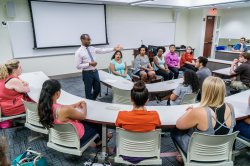Transforming Lectures
According to research on best teaching practices lectures nearly always contained five elements (Bain, 2004).
- A question or problem. People learn best and most deeply when they are trying to solve problems that they have come to regard as important, beautiful and/or intriguing. They also love stories, so good lecturers often tell stories to raise a question or problem.
- Help for students in adopting the question or problem as their own. People learn best and most deeply when they are trying to solve problems that they have come to regard as important, beautiful and/or intriguing. Good lecturers help students see the significance, beauty and intrigue of the problem. Sometimes they do that with a good story, or by connecting the question or problem to some larger question or problem.
- Engagement of the students in higher order thinking (applying, analyzing, synthesizing, evaluating) about the question or problem (using active learning). People learn best by doing and getting feedback on their efforts; if you want them to learn to think critically, they must have opportunities to do so. Highly effective lectures engage students in thinking critically through the problem or questions; they don’t just ask students to remember information or memorize procedures.
- A tentative answer or solution. When people learn deeply, they construct their own understanding of what something means, how it might be applied, what its implications are, and so forth. Outstanding lecturers help students construct, apply, analyze, synthesize and evaluate meaning. They don’t just try to pour information in students’ ears.
- A new question or problem. How do we understand the problem or question now? What ’s the next question? What problems arise once we solve this one?
While the lectures of outstanding teachers nearly always contained these five elements, many ineffective lectures contained only the fourth element, an answer to a question nobody had raised.
Ironically, some outstanding lecturers sometimes leave out the fourth element. They help students understand and buy into a question, engage them in higher order thinking about the question, and send them off to pursue the question, now understood in a whole new way (thus, a new question).
Delivering the Great Lecture
The five elements shape the great lecture, but effective delivery helps too. How can you deliver the lecture more effectively? Here are some hints we heard from highly effective lecturers:
- Have good intentions. When we asked highly effective lecturers what they intended when they lectured, they said they wanted to help students understand. provoke them to think differently, apply their understanding, analyze, synthesize and evaluate. When we asked not so successful lecturers, they often said they wanted to cover the material. In contrast, great lecturers wanted to uncover the material. At best, less successful lecturers said they wanted to help students remember or “to pick out the key information” they were supposed to remember, but these teachers seldom if ever said they wanted to help students think. Let good intentions guide everything you do: the eye contact you make with students, the little pauses you use to let key points land, the questions you ask, the rhetorical questions you employ, the clear and provocative explanations you utilize, the posture you assume. Help students begin to build their understanding, but also provoke them to think critically and creatively, and give them some time and space to do so. [While students have the most difficulty with higher order thinking, traditional lecturers, at best, concentrate only on the lower order abilities: remembering and understanding].
- Treat the lecture as a conversation, even if you are doing most of the talking. People learn deeply by engaging in a conversation with themselves. Encourage that conversation. Look into students’ eyes. Read their reactions and change pace or explanations when appropriate. Engage students in thinking with you. Don’t just “cover” the material. Engage them in two-way talk. Listen and respond to students.
- Recognize that the lecture has some performance qualities. Fill the room with your presence. Make sure everyone can hear you and see any illustrations. Don’t hide behind the podium. Repeat key points. Change pace every ten minutes. Allow time for students to answer and think about the material presented. Entertain by provoking thought, showing a sense of humor, and displaying enthusiasm. Create an inner tension, a sense of anticipation or curiosity. Show your interest in the material and in the students. Show you are interested in what they learn. Try to end with an intellectual bang.
Stop Delivering the Lecture
Remember, however, the purpose of the lecture is not for you to perform, but for the students to learn. Stop frequently, pose problems, get students to work on them individually, in pairs, in small groups, and then to report back. Listen and respond. Let students respond to one another.
Recording Video Lectures
6.27.20
